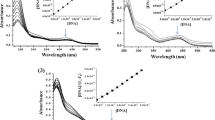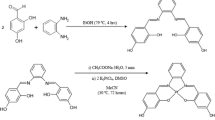Abstract
Two new ligands derived from phloroglucinol 2-{[(4-methoxy benzoyl ) oxy ] } methyl benzoic acid[L1] and 2-{[(4-methyl benzoyl )oxy] methyl} benzoic acid[L2] were synthesized. The solid complex Eu(III)-L2 has been synthesised and characterized by elemental analysis ,UV and IR spectra. The reaction of Eu(III) with the two synthesized ligands has been investigated in I = 0.1 mol dm-3 p-toluene sulfonate by cyclic voltammetry and square wave voltammetry. The reaction of Eu (III)–L1 and Eu (III)–L2 binary complexes with nucleotide 5′-AMP , 5′-ADP ,5′-ATP , 5′- GMP , 5′-IMP , and 5′-CMP has been investigated using UV, fluorescence and electrochemical methods. The experimental conditions were selected such that self-association of the nucleotides and their complexes was negligibly small, that is, the monomeric complexes were studied. The interaction of the Eu(III)–L1 or L 2 solid complexes with calf-thymus DNA has been investigated by fluorescence and electrochemical methods including cyclic voltammetery(CV) ,differential pulse polarography (DPP) and square wave voltammetry (SWV) on a glassy carbon electrode. The fluorescence intensity of Eu(III)-L2 complex was enhanced with the addition of DNA. Under optimal conditions in phosphate buffer pH 7.0 at 25 °C the linear range is 3–20 μM for calf thymus DNA (CT–DNA) and the corresponding determination limit is 1.8 μM.





















Similar content being viewed by others
References
Wisespongpand P, Kuniyoshi M (2003) Bioactive phloroglucinols from the brown alga Zonaria diesingiana. J Appl Phycol 15:225–228
Broadbent D, Mabelis RP, Spencer H (1976) C-acetylphloroglucinols from Pseudomonas fluorescens. Phytochemistry 15(11):1785
Mathegka ADM, Meyer JJM, Horn MM, Drewes SE (2000) An acylated phloroglucinol with antimicrobial properties from Helichrysum caespititium. Phytochemistry 53:93–96
Meyer JJ, Lall N, Mathegka ADM (2002) Extraction of antibacterial compounds from Combretum microphyllum (Combretaceae). S Afr J Bot 68:90–93
Mathekga ADM (2001) Antimicrobial activity of Helichrysum species and the isolation of a new phloroglucinol from Helichrysum caespititium. Doctoral thesis at the University of Pretoria.
Yamaki M, Miwa M, Ishiguro KS, Takagi S (1994) Antimicrobial activity of naturally occurring and synthetic phloroglucinols against Staphylococcus aure. Phytother Res 8:112–114
Rocha L, Marston A, Potterat O, Kaplan MAC, Hostettmann K (1996) More phloroglucinols from Hypericum brasiliense. Phytochemistry 42:185–188
Heilmann J, Winkelmann K, Sticher O (2003) Studies on the antioxidative activity of phloroglucinol derivatives isolated from Hypericum species. Planta Med 69:202–206
Tziveleka L, Vagias C, Roussis V (2003) Natural products with anti-HIV activity from marine organisms. Curr Top Med Chem 3:1512–1535
Singh IP, Bharate SB (2006) Phloroglucinol compounds of natural origin. Nat Prod Rep 23:558–591
Verotta L (2003) Are acylphloroglucinols lead structures for the treatment of neurodegenerative diseases? Phytochem Rev 1:389–407
Mandix K, Colding A, Elming K, Sunesen L, Shim I (1993) Ab initio investigation of phloroglucinol. Int J Quant Chem 46:159–170
Spoliti M, Bencivenni L, Quirante JJ, Ramondo F (1997) Molecular conformations and harmonic force field of 1,3,5-benzenetriol molecule from ab initio and density functional theory investigations. J Mol Struct (Theochem) 390:139–148
National Hygienic Standards for the Usage of Food Additives, GB (1996) Standardization Administration of China: pp 2760–1996
Jayabalan M, Thomas V, Rajesh PN (2001) Polypropylene fumarate/phloroglucinol triglycidyl methacrylate blend for use as partially biodegradable orthopaedic cement. Biomaterials 22:2749–2757
Higuchi K, Motomizu S (1999) Flow-injection spectrophotometric determination of nitrite and nitrate in biological samples. Anal Sci 15:1
Pesez M, Bartos J (1974) Colorimetric and fluorimetric methods of analysis. Dekker, New York, p 109
Buono-core GE, Marciniak B, Li H (1990) Coord Chem Rev 99:55–87
Wu WN, Tang N, Yan L (2008) J Fluoresc 18:101–107
Wang QM, Yan B (2004) J Mater Chem 14:2450
Edward A, Chu TY, Claude C, Sokolik I, Okamoto Y, Dorsinville R (1997) Synth Met 84:433–434
Kido J, Nagai K, Okamoto Y (1993) J Alloys Compd 192:30
Yu JB, Zhou L, Zhang HJ, Zheng YX, Li HR, Deng RP, Peng ZP, Li ZF (2005) Inorg Chem 44:1611
Kukhta A, Kolesnik E, Grabchev I (2006) J Fluoresc 16:375–378
Meares CF, Wensel TG (1984) Acc Chem Res 17:202
Wu FB, Zhang C (2002) Anal Biochem 311:57–67
Nishioka T, Yuan J, Yamamoto Y, Sumitomo K, Wang Z, Hashino K, Hosoya C, Ikawa K, Wang G, Matsumoto K (2006) Inorg Chem 45:4088–4096
Scott LK, Horrocks WD (1992) J Inorg Biochem 46:193
Niyama E, Brito HF, Cremona M, Teotonio EES, Reyes R, Birto GES, Felinto MCFC (2005) Spectrochim Acta Part A 61:2643–2649
Lehn JM (1990) Angew Chem Int Ed Engl 29:1304–1319
An BL, Gong ML, Li MX, Zhang JM, Cheng ZX (2005) J Fluoresc 15:613–617
Lv Y, Zhang J, Cao W, Juan JC, Zhang F, Xu Z (2007) J Photochem Photobiol A 188:155–160
Meshkova SB (2000) J Fluoresc 10:333–337
Wood KC, Little SR, Langer R, Hammond PT (2005) A family of hierarchically self-assembling linear-dendritic hybrid polymers for highly efficient targeted gene delivery. Angew Chem Int Ed 44:6704–6708
Sassolas A, Leca-Bouvier BD, Blum LJ (2008) DNA biosensors and microarrays. Chem Rev 108:109–139
Epstein JR, Biran I, Walt DR (2002) Fluorescence-based nucleic acid detection and microarrays. Anal Chim Acta 469:3–36
Zheng W, He L (2009) Label-free, real-time multiplexed DNA detection using fluorescent conjugated polymers. J Am Chem Soc 131:3432–3433
Yang R, Tang Z, Yan J, Kang H, Kim Y, Zhu Z, Tan W (2008) Noncovalent assembly of carbon nanotubes and single-stranded DNA: an effective sensing platform for probing piomolecular interactions. Anal Chem 80:7408–7413
Liu Y, Wang Y, Jin J, Wang H, Yang R, Tan W (2009) Fluorescent assay of DNA hybridization with label-free molecular switch: reducing background-signal and improving specificity by using carbon nanotubes. Chem Commun 665–667.
Ws KN, O’Connell M, Wisdom JA, Dai HJ (2005) Carbon nanotubes as multifunctional biological transporters and nearinfrared agents for selective cancer cell destruction. Proc Natl Acad Sci USA 102:11600–11605
Tyagi S, Kramer FR (1996) Molecular beacons: probes that fluoresce upon hybridization. Nat Biotechnol 14:303–308
Azab HA, Anwar ZM, Ahmed RG (2010) Pyrimidine and purine mononucleotides recognition by trivalent lanthanide complexes with N-acetyl amino acids. J Chem Eng Data 55(1):459–475
Azab HA, El-Korashy SA, Anwar ZM, Hussein BHM, Khairy GM (2010) Synthesis and Fluorescence properties of Eu-anthracene-9-carboxylic acid towards N-acetyl amino acids and nucleotides in different solvents. Spectrochim Acta A Mol Biomol Spectrosc 75:21–27
Azab HA, Abd El-Gawad II, Kamel RM (2009) Ternary complexes formed by the fluorescent probe Eu (III)-9-anthracene carboxylic acid with pyrimidine and purine nucleobases. J Chem Eng Data 54:3069–3078
Azab HA, El-Korashy SA, Anwar ZM, Hussein BHM, Khairy GM (2010) Eu(lll)-anthracene-9-carboxylic acid as a responsive luminescent bioprobe and its electroanalytical Interactions with N-acetyl amino acids, nucleotides and DNA. J Chem Eng Data 55:3130–3141
Azab HA, Abd El-Gawad II, Kamel RM (2009) Ternary complexes formed by the fluorescent probe Eu (III)-9-anthracene carboxylic acid with pyrimidine and purine nucleobases. J Chem Eng Data 54:3069–3078
Filip W, Mojmir S, Li AX, Azab HA, Bartha R, Hudson RHE (2007) A robust and convergent synthesis of dipeptides-DOTAM conjugates as chelators for lanthanide ions: new PARACEST MRI agents. Bioconjug Chem 18(5):1625–1636
Orabi AS, Azab HA, ElDeghidy FS, Said H (2010) Ternary complexes of La(III), Ce(III), Pr(III) or Er(III) with adenosine 5’-mono,5’-di, and 5’-triphosphate as primary ligands and some biologically important zwitterionic buffers as secondary ligands. J Solution Chem 39:319–334
Azab HA, Al-Deyab SS, Anwar ZM, Gharib RA (2011) Fluorescence and electrochemical probing of N-acetylamino acids, nucleotides and DNA by Eu(lll) -bathophenanthroline complex. J Chem Eng Data 56(4):833–849
Azab HA, Al-Deyab SS, Anwar ZM, Kamel RM (2011) Potentiometric, electrochemical and fluorescence study of the coordination properties of the monomeric and dimeric complexes of Eu(lll) with nucleobases and PIPES. J Chem Eng Data 56:1960–1969
Azab HA, Al-Deyab SS, Anwar ZM, Abd El-Gawad II, Kamel RM (2011) Comparison of the coordination tendency of amino acids, Nucleobases or mononucleotides towards the monomeric and dimeric lanthanide complexes with biologically important compounds. J Chem Eng Data 56:2613–2625
Suh D, Chaires JB (1995) Criteria for the mode of binding of DNA binding agents. Bioorg Med Chem 3:723–728
Nicholson RS (1965) Theory and application of cyclic voltammetry for measurement of electrode reaction kinetics. Anal Chem 37:135
Author information
Authors and Affiliations
Corresponding author
Rights and permissions
About this article
Cite this article
Azab, H.A., Anwar, Z.M., Abdel-Salam, E.T. et al. New Luminescent Bioprobes Eu(lll)-phloroglucinol Derivatives and Their Spectrofluorimetric, Electrochemical Interactions with Nucleotides and DNA. J Fluoresc 22, 223–238 (2012). https://doi.org/10.1007/s10895-011-0949-5
Received:
Accepted:
Published:
Issue Date:
DOI: https://doi.org/10.1007/s10895-011-0949-5




